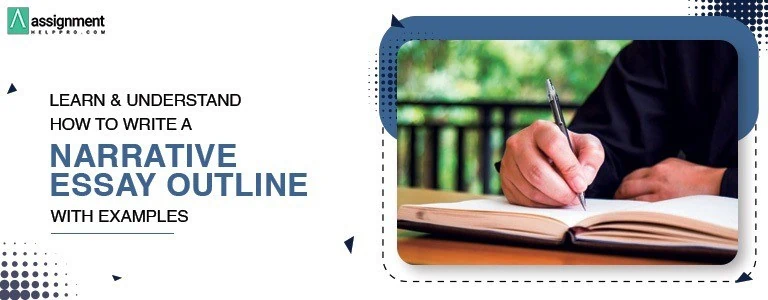Have your instructor asked you to write a narrative essay? If yes, then first make sure to prepare a narrative essay outline so that you can include all the important points in your essay without omitting any. In case, you are not sure what a narrative essay outline means and how to write it effectively, continue reading this blog. Here, you will learn more details about narrative essay outline writing.
Definition of Narrative Essay
A narrative essay is a popular academic essay type in which the writer has to narrate a story. It is one of the most commonly assigned creative pieces of academic writing which combines both essay composition and storytelling.
In general, the narrative essay is a kind of short story, but the major difference is that it follows the essay structure that includes an introduction, body, and conclusion. In order to engage the readers, this essay type provides a vivid description of the events and also creatively narrates an incident or personal experience in the form of a story with a set of characters, plot, dialogue, conflict, twists, resolutions, and a moral lesson.
The stories in the narrative essays can be real or fictional. Unlike other types of essays, narrative essays should be written in the first person. Some common forms of narrative essays include personal narrative essays, descriptive narrative essays, reflective narrative essays, nonfiction narrative essays, biographical narrative essays, and historical narrative essays.

An Overview of Narrative Essay Writing
If you are asked to write a narrative essay, the first thing you need is a good essay topic or prompt. Mainly, to write an engaging essay, on the internet, there are a lot of narrative essay topics available for you to choose from.
Personal experiences from your school, college, vacations, parties, or any other interesting life events can also serve as topics for the narrative essay.
Keep in mind that the narrative essay topic you choose is only considered good if it
- Matches your interest.
- Relates to you or has a personal connection with you.
- Gives a proper meaning to you.
- Goes well with your writing style.
- Satisfies with your instructor’s guidelines.
There are no defined criteria for selecting a narrative essay topic. You can come up with a story around any subject. However, if you want to write an outstanding essay, choose a subject that is based on your real-life experience.
Is it enough to have a good topic on its own to write an interesting narrative essay? No, in addition to the topic, you should prioritize the essay’s content and narration flow. Therefore, after choosing a topic for your essay, you should create a narrative essay outline. Then, using the outline as a guide, you should write the essay’s content in a structured manner with important sections like an introduction, body, and conclusion. Lastly, you should proofread the entire essay after writing it.
What is a Narrative Essay Outline?
A narrative essay outline is a brief essay plan that will assist you in organizing the primary ideas and structuring the content’s flow. Typically, it serves as a guide for writing the essay without skipping important points. As a result, prior to writing the essay’s content, experts always advise creating a narrative essay outline on the topic chosen.
Although creating an outline for your essay is not required, doing so has numerous advantages as listed below.
- It aids in the logical association of information and the organization of thoughts.
- It gives the essay a good structure.
- You are free to include any and all pertinent information.
- Rearranging the information is simple.
- It helps keep the flow of the essay consistent.
Narrative Essay Outline Writing Steps
Writing a narrative essay is not a tedious process when compared to other types of academic essays. Particularly, for writing a narrative essay, you don’t need to follow any specific guidelines or rules. You can simply write your own stories in your comfortable writing style. But, before you start writing your narrative essay, it is advisable to sketch a proper narrative essay outline.
So, how to develop a narrative essay outline? Like other types of essays, you can also create a narrative essay outline as per the standard 5-paragraph essay structure that includes the following essential sections.
- Introduction
- Body
- Conclusion
Remember, it is not mandatory to present the narrative essay in a 5-paragraph structure. Depending upon your writing needs and the topic you have chosen, you can also structure the narrative essay outline with 6 or more paragraphs.
Now, let us have an in-depth insight into the narrative essay outline sections.
Narrative Essay Introduction
In a narrative essay, the introduction is the most crucial section that will help you to either create or break the image of your essay. So, in order to make your readers read the entire essay and grab their attention, first, you should write a compelling narrative essay introduction by adding the following things.
- The hook statement
- Scene Setting
- The thesis statement
The Hook Statement
Begin the introductory paragraph with a catchy hook statement to engage the readers in your essay. Your hook can be an intriguing statement, a quote, a fact, or a rhetorical question.
Scene Setting
Next to the hook, give a glimpse of your story and make your readers understand what is happening. Here, you should only set the scene of the story by providing brief background information. Do not share the whole story in the introduction paragraph; just inform your readers how the story points relate to you.
The Thesis Statement
It is an important element that should be placed at the end of the introduction paragraph to boost the effectiveness of the essay. The thesis statement should tell the readers what your story is all about. In simple terms, here, you should give a sneak peek of what you are going to discuss in the whole essay.
Narrative Essay Body
It is the major section of your essay where you should present the details of your story and guide the readers through the plot. According to the 5-paragraph structure, the body section should be divided into 3 paragraphs.

In order to make your body paragraphs interesting and impressive, each body paragraph includes the below-mentioned key elements.
- Vivid Description
- Dialogues
- Characters
- Chronological Order
- Climax
Vivid Description
As the narrative essay is all about setting up a scene, you should provide a vivid description of the event to etch a clear picture in the reader’s mind. With the help of vivid descriptions, you can take the readers to the actual happening of an event.
Dialogues
To give life to a story and to make the story’s atmosphere real, use dialogues. In general, the dialogue will help you to narrate a story effectively.
Characters
The characters are those who are involved in a story or the people who are acting in it. When narrating a story, provide a detailed description of the characters that are involved in your story and the role they have played in your story.
Chronological Order
Telling the story in a proper sequence is the most important thing that needs to be considered when writing a narrative essay. To make your essay organized and to help your readers understand your story, you should narrate the story in chronological order as per the actual happening of the event.
Climax
The breaking point of the story is the climax. Here, you should give a detailed description by including all the real emotion that engages the readers’ five senses, i.e., smell, sight, touch, hearing, and taste. Avoid exaggerating the climax. Make sure to provide the actual climax accurately without making any changes.
Narrative Essay Conclusion
The final section of a narrative essay is the conclusion paragraph where you need to summarize your entire essay and give some final comments about the story.
Like the introduction, the conclusion should be engaging, and it should also be given equal importance. When drafting the conclusion, make sure to include the following elements.
- Thesis restatement
- Lesson learned from the story
- A call to action
Thesis restatement
In the conclusion paragraph, at first, mention the thesis restatement by highlighting the main details that you have already shared in the body paragraph.
Lesson learned from the story
Next, share the lesson you have learned from the story or the moral of the story that you want your readers to look upon.
A call to action
Finally, at the end of the conclusion paragraph, provide a call to action that persuades the readers to think more about your narrative essay topic.
Remember, your essay outline creation process will be less stressful if you follow all the above-mentioned steps properly. So, make sure to follow each and every step carefully and organize the structure of your essay effectively without collapsing the narration of the story.
Standard Template of a Narrative Essay Outline
Mentioned below is the standard narrative essay outline template you can consider while preparing the outline.
Template 1
Introduction
- Hook
- Background
- Thesis Statement
Body Paragraphs
- Situation
- Rising Action
- Climax
Conclusion
- Thesis restatement
- Lessons Learned
- Call to Action
Template 2
Here is another detailed sample narrative essay outline template that you can use when you are asked to write a narrative essay that contains a sequence of events in a story.
Introduction
- Hook statement
- Topic Significance
- Thesis statement
Set-Up
- Event background (History of people or event and its relevant details)
- Characters involved (Description of physical and personality characteristics)
- Settings (Description of setting using 5 senses and explanation of the significance of the setting)
- Foreshadowing (Details establishing conflicts and the stakes for people)
Beginning of the event
- Explain how things started
- A high point of the event
- Detailed sensory description of the event that happened
- Feelings about what happened
Climax of the event
- Explain the end of the event.
- Detailed sensory description of the event that happened
- Feelings about what happened
Resolution of the event
- Tell me how things end up.
- Sum up the event
Narrative Essay Outline Examples
If you are not sure how to write a narrative essay outline, then check the below-mentioned narrative essay outline examples and get a clear idea.
Example 1
Here is a sample narrative essay outline on the topic “My First Japanese Pastry”.
Introduction
- Hook: Japan is known as the “Land of the Rising Sun”.
- Background: I thought Japan was an exotic country with interesting customs and have always wanted to visit Japan.
- Thesis: Eating a Japanese Pastry taught me an important lesson.
Body
- Situation: Once I got off the airplane and walked through the streets of Japan, I felt the same as at home.
- Rising Action: Walking around, I was hungry and wanted to eat something cheap and delicious. I found a bakery and saw a strawberry jam pastry like the one from my home.
- Climax: I tasted the pastry and was surprised to find it was not strawberry jam.
Conclusion
I began to like the sweet bean paste. Also, I learned that many things in Japan look the same as in my country, but they are truly Japanese items, and we should appreciate them. Now, traveling is more enjoyable since I learned that lesson.
Example 2
Here is a sample example of a narrative essay outline on “How I Ran my first marathon”.
Introduction
A time I was afraid of running a marathon
- I resisted when I was asked
- I promised, “I will run next year”.
- I decided.
Body Paragraph 1
Resisted the request
- My run asked me to run a marathon in the year 2010.
- I said No for several reasons.
- She finally participated in the 2010 marathon without me.
Body Paragraph 2
My promise
- Shortly after her run, I promised “Next year”.
- The next year arrived, and she started asking me again.
- I had to agree, but I was not completely prepared.
Body Paragraph 3
My decision to run the marathon
- I was so scared, but I trained diligently.
- When the time arrived, I participated in the race.
- I ran my 3 sections of the race
Conclusion
I did it
- My fear of running long distances restricted me.
- I faced my fear by accepting a new challenge.
- I gained new experience by running in the marathon and also made new friends who are good runners.
Example 3
Here is a sample example of a biographical narrative essay outline on Shakespeare’s biography.
William Shakespeare (1564-1616)
Born at Stanford upon Avon in England.
- Attended grammar school.
Married Anne Hathaway
- She was 26, he was 18
- Had 3 children (Suzanna and twins- Judith and Hamnet)
Left his wife and kids and traveled to London
- Worked as an actor and writer.
- While in London, living the life of an actor – free, liberal, unfaithful to his wife
- Criticized by several writers for not being university educated – called “upstart crow”
Shakespeare and other actors formed a new acting company (1594)
- Was a shareholder in the company – Lord Chamberlain’s Men
- Became most famous – when the Queen died, became King’s Men.
Wrote poetry
- Sonnets-14 line poems with a specific rhyme scheme
Wrote histories, comedies, tragedies, and romances – 37 plays in all.
- Like TV scripts, plays were not considered great literature during his day.
1610 – retired and bought a new big house
- Was famous and rich
- Died in 1616
Conclusion
We hope you have now gained a better comprehension of the definition of a narrative essay outline and the effective ways to prepare it. In case, you have any doubts regarding this topic or if you need expert help in preparing the outline for your narrative essay, approach us immediately.



